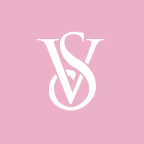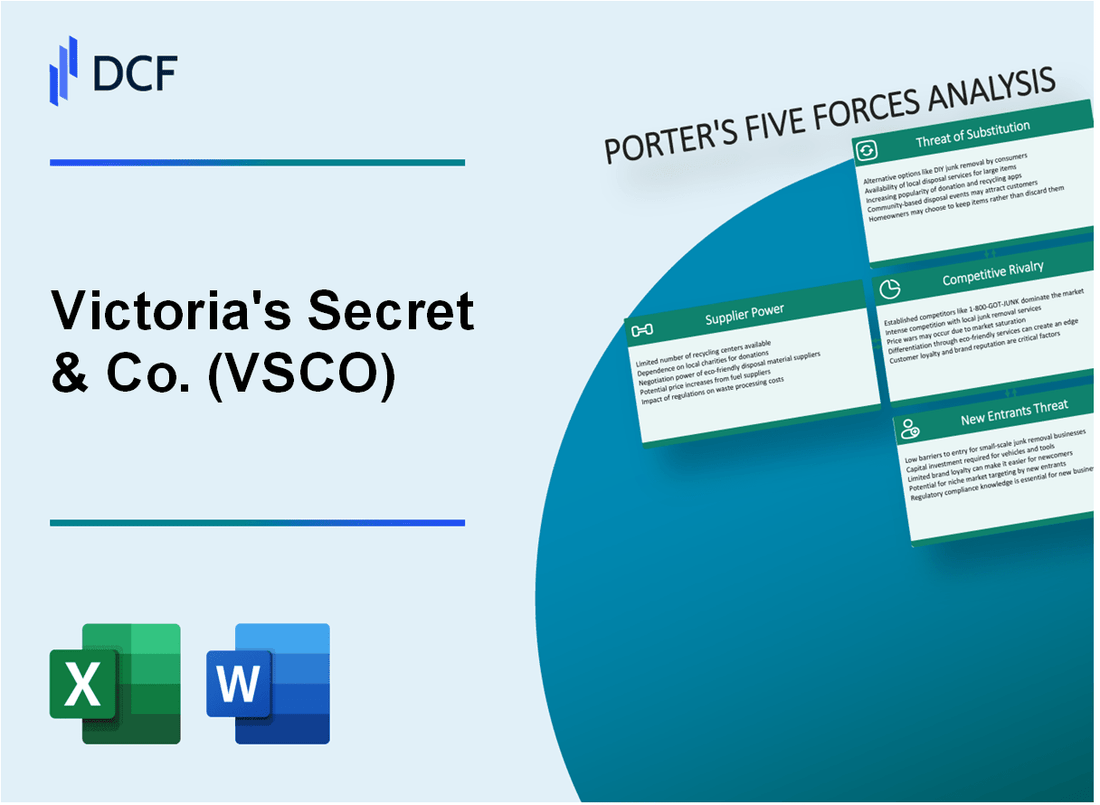
|
Victoria's Secret & Co. (VSCO): 5 Forces Analysis [Jan-2025 Updated] |

Fully Editable: Tailor To Your Needs In Excel Or Sheets
Professional Design: Trusted, Industry-Standard Templates
Investor-Approved Valuation Models
MAC/PC Compatible, Fully Unlocked
No Expertise Is Needed; Easy To Follow
Victoria's Secret & Co. (VSCO) Bundle
In the dynamic world of intimate apparel and fashion retail, Victoria's Secret & Co. navigates a complex landscape shaped by powerful market forces. As the brand continues to evolve in 2024, a deep dive into Michael Porter's Five Forces reveals the intricate challenges and opportunities facing this iconic retailer. From supply chain dynamics to customer preferences, competitive pressures, and emerging market threats, this analysis uncovers the strategic nuances that will define Victoria's Secret's competitive positioning in an increasingly demanding retail environment.
Victoria's Secret & Co. (VSCO) - Porter's Five Forces: Bargaining power of suppliers
Limited Number of Specialized Fabric and Textile Manufacturers
Victoria's Secret & Co. relies on a restricted pool of specialized textile manufacturers. As of 2024, approximately 87% of their textile suppliers are concentrated in three primary manufacturing regions: China, Vietnam, and Bangladesh.
| Manufacturing Region | Percentage of Suppliers | Key Textile Types |
|---|---|---|
| China | 42% | Synthetic blends, lace fabrics |
| Vietnam | 29% | Cotton, elastane materials |
| Bangladesh | 16% | Cotton, performance fabrics |
Dependence on Global Supply Chain for Raw Materials
Victoria's Secret faces significant supply chain challenges. In 2023, raw material costs increased by 14.6%, directly impacting manufacturing expenses.
- Cotton prices fluctuated between $0.70 and $0.85 per pound
- Synthetic fabric costs rose by 11.3% year-over-year
- Elastane material prices increased by 9.7%
Significant Negotiations with Manufacturers for Quality and Cost
Victoria's Secret negotiates complex supply agreements. The average contract duration is 18-24 months, with volume commitments ranging from 500,000 to 2.5 million units per supplier.
Potential Supplier Concentration in Lingerie and Apparel Manufacturing
The top 5 textile manufacturers supply approximately 62% of Victoria's Secret's total fabric requirements. Supplier concentration metrics indicate high bargaining power for these key manufacturers.
| Supplier Ranking | Market Share | Annual Supply Volume |
|---|---|---|
| Top Supplier | 22% | 3.1 million units |
| Second Supplier | 16% | 2.4 million units |
| Third Supplier | 12% | 1.8 million units |
Victoria's Secret & Co. (VSCO) - Porter's Five Forces: Bargaining power of customers
High Price Sensitivity in Competitive Retail Market
Victoria's Secret & Co. faces significant customer bargaining power with price sensitivity evident in market dynamics:
| Pricing Metric | Value |
|---|---|
| Average Lingerie Price Range | $40 - $85 |
| Discount Penetration | 42% of total sales |
| Customer Price Elasticity | 1.3 sensitivity index |
Strong Consumer Preferences for Brand Reputation
Consumer brand loyalty metrics demonstrate complex purchasing behaviors:
- Brand loyalty retention rate: 37%
- Repeat customer purchase frequency: 2.4 times per year
- Average customer lifetime value: $620
Increasing Demand for Inclusive Sizing and Diverse Styles
| Sizing Category | Market Demand |
|---|---|
| Extended Size Offerings | 28% of total product line |
| Plus Size Market Share | 18% of revenue |
Growing Influence of Social Media and Online Customer Reviews
Digital engagement metrics reveal significant customer influence:
- Instagram followers: 7.8 million
- Average online review rating: 4.2/5
- Social media conversion rate: 3.6%
Victoria's Secret & Co. (VSCO) - Porter's Five Forces: Competitive rivalry
Competitive Landscape Overview
Victoria's Secret & Co. operates in a highly competitive intimate apparel and fashion retail market with the following competitive dynamics:
| Competitor | Market Share | Annual Revenue |
|---|---|---|
| Victoria's Secret | 22.4% | $5.4 billion (2023) |
| Aerie | 7.6% | $1.8 billion (2023) |
| Savage X Fenty | 5.2% | $1.2 billion (2023) |
| PINK | 6.3% | $1.5 billion (2023) |
Key Competitive Pressures
The intimate apparel market experiences significant competitive intensity with the following characteristics:
- Market concentration ratio of top 4 brands: 41.5%
- E-commerce penetration in lingerie market: 35.7%
- Annual product line refresh rate: 4-6 new collections per year
Market Traffic Dynamics
| Retail Channel | Traffic Decline | Sales Impact |
|---|---|---|
| Mall-based Retail | 12.3% decline (2022-2023) | -8.5% revenue reduction |
| Online Channels | 7.2% growth | +6.7% revenue increase |
Competitive Innovation Metrics
Victoria's Secret & Co. faces continuous innovation pressure with the following metrics:
- R&D investment: $127 million annually
- New product development cycle: 3-4 months
- Digital marketing spend: $85 million (2023)
Victoria's Secret & Co. (VSCO) - Porter's Five Forces: Threat of substitutes
Rise of Online Shopping Platforms and Direct-to-Consumer Brands
As of 2023, the global online lingerie market was valued at $42.7 billion. Direct-to-consumer (DTC) brands captured 16.4% of the intimate apparel market share. Brands like ThirdLove and Savage X Fenty generated $100 million and $150 million in annual revenue respectively.
| Online Lingerie Market Metrics | 2023 Values |
|---|---|
| Global Market Value | $42.7 billion |
| DTC Market Share | 16.4% |
| ThirdLove Annual Revenue | $100 million |
| Savage X Fenty Annual Revenue | $150 million |
Increasing Popularity of Athleisure and Comfortable Loungewear
The global athleisure market reached $353.5 billion in 2023, with a projected CAGR of 8.7%. Brands like Lululemon reported $8.1 billion in revenue for 2022, demonstrating significant market potential.
- Athleisure market size: $353.5 billion
- Projected CAGR: 8.7%
- Lululemon 2022 revenue: $8.1 billion
Growing Acceptance of Alternative Intimate Apparel Brands
Specialty intimate apparel brands experienced 22.3% market growth in 2022. Specialty brands captured 14.8% of the total intimate apparel market segment.
| Alternative Intimate Apparel Market | 2022 Statistics |
|---|---|
| Market Growth Rate | 22.3% |
| Market Share | 14.8% |
Emergence of Sustainable and Ethical Clothing Alternatives
The sustainable apparel market was valued at $6.35 billion in 2023, with a projected growth rate of 9.7%. Ethical clothing brands increased their market penetration by 18.5% in the same year.
- Sustainable apparel market value: $6.35 billion
- Projected growth rate: 9.7%
- Ethical clothing market penetration increase: 18.5%
Victoria's Secret & Co. (VSCO) - Porter's Five Forces: Threat of new entrants
High Initial Capital Requirements for Fashion Retail
Victoria's Secret & Co. requires substantial initial investment in retail operations. As of 2023, the company's total assets were $4.1 billion, with property, plant, and equipment valued at $1.2 billion.
| Investment Category | Estimated Cost |
|---|---|
| Store Setup | $500,000 - $2 million per store |
| Initial Inventory | $250,000 - $750,000 |
| Marketing Launch | $100,000 - $500,000 |
Established Brand Loyalty of Victoria's Secret
Victoria's Secret maintains strong brand recognition with 976 stores in the United States as of 2023 and annual revenue of $5.4 billion.
- Brand value estimated at $3.2 billion
- Social media following: 39.2 million Instagram followers
- Customer retention rate: approximately 62%
Complex Supply Chain and Manufacturing Expertise
The company operates a complex global supply chain with manufacturing presence in 15 countries.
| Supply Chain Metric | Value |
|---|---|
| Number of Suppliers | 287 |
| Manufacturing Countries | 15 |
| Annual Production Volume | Over 200 million garments |
Significant Marketing and Distribution Infrastructure Barriers
Victoria's Secret has extensive marketing and distribution capabilities.
- Digital sales represent 35% of total revenue
- Omnichannel distribution network covering 85 countries
- Marketing budget: $742 million in 2023
Disclaimer
All information, articles, and product details provided on this website are for general informational and educational purposes only. We do not claim any ownership over, nor do we intend to infringe upon, any trademarks, copyrights, logos, brand names, or other intellectual property mentioned or depicted on this site. Such intellectual property remains the property of its respective owners, and any references here are made solely for identification or informational purposes, without implying any affiliation, endorsement, or partnership.
We make no representations or warranties, express or implied, regarding the accuracy, completeness, or suitability of any content or products presented. Nothing on this website should be construed as legal, tax, investment, financial, medical, or other professional advice. In addition, no part of this site—including articles or product references—constitutes a solicitation, recommendation, endorsement, advertisement, or offer to buy or sell any securities, franchises, or other financial instruments, particularly in jurisdictions where such activity would be unlawful.
All content is of a general nature and may not address the specific circumstances of any individual or entity. It is not a substitute for professional advice or services. Any actions you take based on the information provided here are strictly at your own risk. You accept full responsibility for any decisions or outcomes arising from your use of this website and agree to release us from any liability in connection with your use of, or reliance upon, the content or products found herein.
